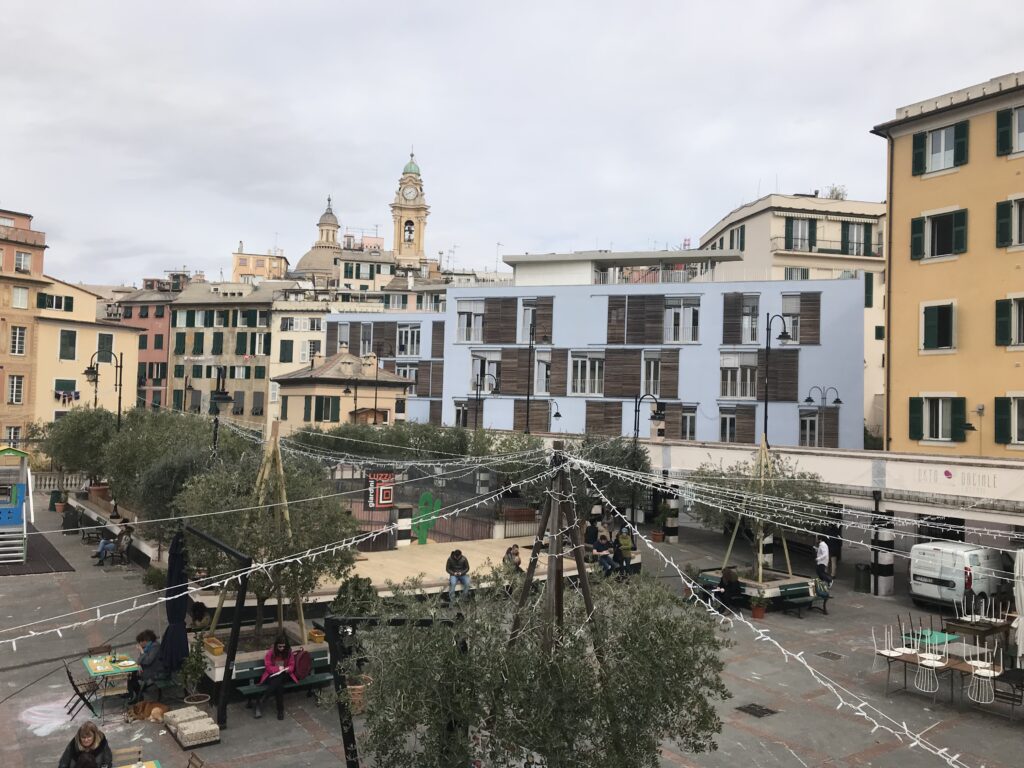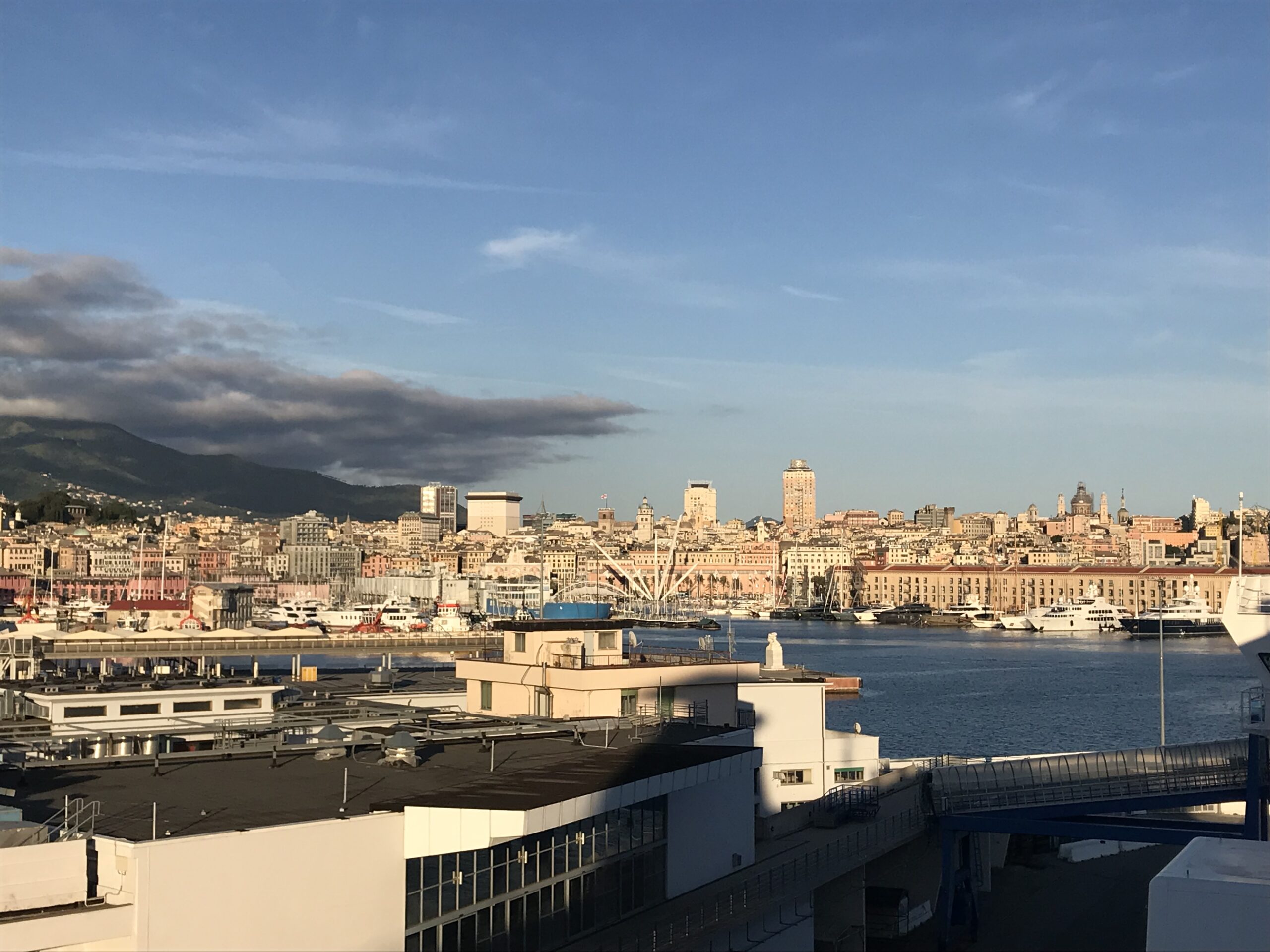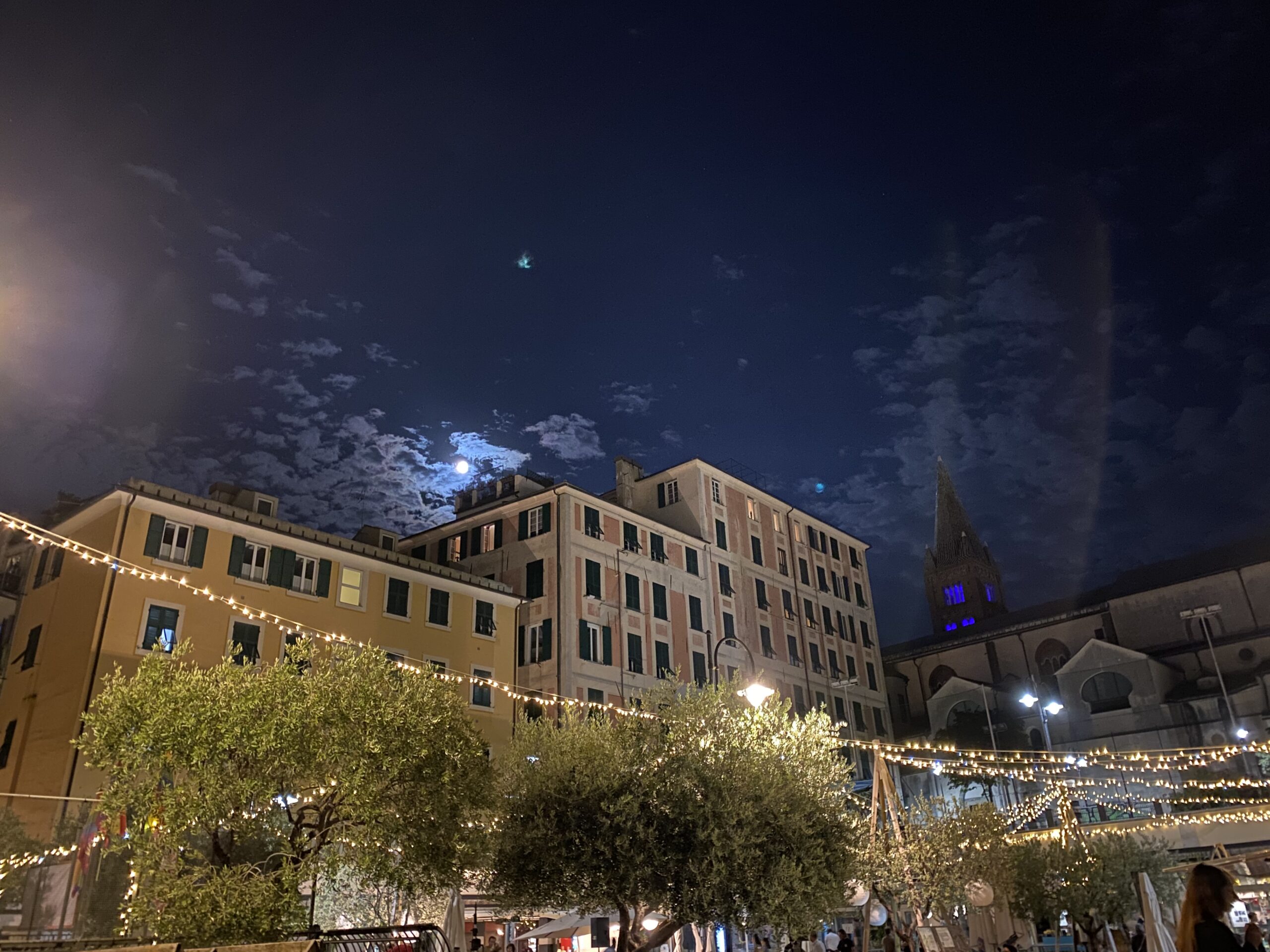

I’m convinced that fairy lights and olive trees instantly brighten the vibes of a place. But this isn’t what struck me most the first time I entered Giardini Luzzati, a communal, social space in the historic center of Genoa, a port city in Northern Italy.
Dozens of colorful tables are laid out on the square beneath San Donato’s bell tower and occupied by the most eclectic crowd. A group of students is vividly quizzing each other over open textbooks. Next to them, a couple is sipping spritzes, while their child makes friends in the kids play area.
An older gentleman is playing chess nearby, receiving curious looks from tourists tasting the city’s famous pesto genovese for the first time. In the distance, a musician is tuning up on stage, punctuated by screams of teenagers from the football pitch behind the bar. Giardini Luzzati is a space for everyone, a microcosm in the heart of Genoa.
Squeezed between the Ligurian Alps and the Mediterranean Sea, Genoa is a multifaceted city, filled with beauty and contradictions. A few steps away from the historical waterfront, Genoa’s medieval center boasts forty-two ostentatious and UNESCO-listed palaces, remnants of its past glory as one of the most powerful maritime republics in the world. The city can look decadent to the untrained eye, with grandiose façades decaying in the dark vicoli, its industrial port, and areas marked by social and economic disparity.
There’s something jarring but oddly beautiful when you walk through these alleyways so narrow sunbeams barely filter through, the rumble of tourists’ suitcases on the cobbled streets mingling with chatters in various languages of business owners, loitering groups, sex workers, and the smell of spices blended with those of piss and freshly baked focaccia. You might turn around, and suddenly be standing in front of a palace with centuries-old fresco painted on the crumbling facades, just above an ‘ACAB’ graffiti.

As per the city’s tagline, Genoa is “more than this”—and Giardini Luzzati’s origin story exemplifies this. In the 1990s, the square was set to become a parking lot in the heart of the increasingly desolate and deteriorating historic center, associated with noise, danger, and often immigration.
In the 1950s, Genoa had become home to hundreds of thousands of people migrating from the South of Italy, and migratory flows from other countries (such as Morocco and Eritrea) kept increasing. Most lived in degraded streets while former residents fled the city center. Genoa started renovating the waterfront in the 1990s, but the freshly refurbished and now expensive apartments only contrasted more with the decaying city center next door, and the economic struggles of refugees.
Building a parking lot in the city center certainly stemmed from the idea of drawing Genoese back in, but those plans were given up when Roman ruins were discovered there—ruins that are still part of the communal space and a hot spot to play the local card game, Cirulla.
The social co-operative Il Ce.Sto became the concessionaire of the square in 2012, meaning the municipality granted them the right to use and manage the space freely. Il Ce.Sto had already been operating for forty years in that part of the historic center called Sestiere del Molo, focusing on social services in migrant and homeless centers. The co-operative created gardens (giardini), named after Genoese artist Emanuele Luzzati, hoping to bring the city center back to life.
But unlike the security policies gaining ground in the center, Il Ce.Sto was determined to make the space inclusive to all the residents. They initially drew on the network they had already built, with families and kids who had attended community centers, second-generation immigrants, associations of foreign citizens, and other locals.
Giardini Luzzati started organizing social and cultural events with various artists and educators and enabled other associations to use the space for meetings, thus immediately attracting people. They initially didn’t receive public funding, making their bar essential to sustain the space while ensuring most events were free to guarantee accessibility.
12 years later, Giardini Luzzati welcomes about 30,000 people a month, half of them regulars, such as Genoese student Parisa: “This place makes me more social.” The public square has become not an oasis, but an agora—a free and safe space for everyone to socialize, study, be entertained, exchange ideas and experiences, or just have a drink. The space centralizes all the activities typically found in bars, libraries, nightclubs, and gyms, reminiscent of community halls from the past, where the first exchange isn’t transactional but rather a dialogue between cultures and generations.
While Il Ce.Sto focuses on social welfare, Giardini Luzzati enriches its mission by adding a cultural layer. Art and culture are not seen as a consumption product but as a form of self and collective care that gives voice to social values. “Giving people the opportunity to enjoy and be stimulated by culture for personal growth to become better citizens is fundamental,” said Marco Montoli, president of the co-operative from 2009 to 2024.

For instance, the space organizes Primavere in March, a series of events giving visibility to women artists, athletes, writers, and activists. But the busiest month for Giardini Luzzati is June, with two of its key events: Liguria Pride, where the square becomes a ‘Village’ blooming with activities and the culminating point of Genoa’s pride parade, and the week around World Refugee Day, with a range of cultural events and talks about immigration, inclusivity, and human rights.
Giardini Luzzati made a point to include younger people in its community: educators and parents work hand in hand to organize games and talks, from yoga sessions to discussions around sustainability or puberty. By providing all children with a space to socialize and learn outside of school, Il Ce.Sto wants to ensure kids feel equal regardless of their background.
But last June, Giardini Luzzati’s mission was threatened by the far-right party, La Lega. They accused the space of promoting ‘gender theory’ to children during Liguria Pride and called on Genoa’s mayor to revoke the space’s concession.
Giardini Luzzati had been hosting the Village Kids, a space for child-friendly activities during Pride week, for five years without receiving any complaints. Il Ce.Sto addressed La Lega publicly, reaffirming their commitment to inclusivity and wondering if those accusations had anything to do with the concurrent European Parliament elections, which saw a large shift towards the far right in many countries.
The Genoese community rallied to support the public space soon after. 18 associations and businesses wrote an appeal called “Hands off the Luzzati,” and Councilor Filippo Bruzzone, for example, used the opening statement of a town meeting to bring up the issue and ask other political forces to take a stance. Bruzzone deemed it essential, both as a concerned citizen and Genoa’s first openly gay council member, to defend marginalized voices, especially in the current right-wing government.
However, the intervention of Marco Bucci, center-right mayor of Genoa since 2018, ended the conflict. Although he has been called out for past declarations that did not support Pride or Giardini Luzzati, Bucci now backs up the initiatives led by the space. A few months before, he had even endorsed them on national TV, acknowledging their pioneering role in opening a dialogue and creating value for everyone in Genoa, and the need to build a system representing everyone.
Il Ce.Sto’s former president, Marco Montoli, considered it a victory for democracy, stemming not from interests but from objective facts. “Even though Mayor Bucci hasn’t always fully backed us up, the social impact of Giardini Luzzati is so significant that no one can afford to challenge it,” he stated.
At the same time, Montoli made it very clear that Giardini Luzzati doesn’t do politics, but is rather interested in politics and political debate. “We practice active citizenship, and what we do benefits everyone,” he said. While Montoli acknowledged the positive outcomes from joint efforts with local government (Il Ce.Sto now receives about 5 million euros of public funding from the municipality and the region), he emphasized the need for a shared vision between citizens and the city’s decision-makers—a stance supported by Counsellor Bruzzone, who affirms this public space should serve as an example to extend to other parts of the city.

Il Ce.Sto pushes for more collaboration with institutions regardless of political views, to involve everyone in the city’s plans for its historic center, and avoid turning it into a tourist attraction, an open-air museum that would erase its social fabric.
Giardini Luzzati acts as a model of the revitalization of the area with activities and support for all the residents and local businesses while recognizing the contrasting reality of the neighborhood. This enhances the whole city by creating lasting benefits that ripple outward. Giardini Luzzati has continuously fostered job insertion (a hundred young people, half of whom are not Italian, work there) and saved the city substantial sums with their projects.
But beyond economics, the space has generated incredible social value for everyone. An analytical tool called SROI (Social Return on Investment) revealed that every euro invested in Giardini Luzzati’s activities generates €1.90 in social value for the entire city, reinforcing the quality of life and safety at night, backed up by a recent visitor survey.
Defying global divisive rhetoric and an epidemic of loneliness, Giardini Luzzati is a reminder that everyone has the right to be the protagonist of a new way of living in the city. Far from idealization, they have successfully translated social values into scalable results. Il Ce.Sto intends to spread this model throughout Genoa’s suburbs and has even been asked by other cities such as Naples and Bologna to bring their expertise in creating a communal space.
There is strength in community, and it just takes the lead where the city can’t, placing community back at the center, along with the fairy lights and olive trees.
I’m convinced that fairy lights and olive trees instantly brighten the vibes of a place. But this isn’t what struck me most the first time I entered Giardini Luzzati, a communal, social space in the historic center of Genoa, a port city in Northern Italy.
Dozens of colorful tables are laid out on the square beneath San Donato’s bell tower and occupied by the most eclectic crowd. A group of students is vividly quizzing each other over open textbooks. Next to them, a couple is sipping spritzes, while their child makes friends in the kids play area.
An older gentleman is playing chess nearby, receiving curious looks from tourists tasting the city’s famous pesto genovese for the first time. In the distance, a musician is tuning up on stage, punctuated by screams of teenagers from the football pitch behind the bar. Giardini Luzzati is a space for everyone, a microcosm in the heart of Genoa.
Squeezed between the Ligurian Alps and the Mediterranean Sea, Genoa is a multifaceted city, filled with beauty and contradictions. A few steps away from the historical waterfront, Genoa’s medieval center boasts forty-two ostentatious and UNESCO-listed palaces, remnants of its past glory as one of the most powerful maritime republics in the world. The city can look decadent to the untrained eye, with grandiose façades decaying in the dark vicoli, its industrial port, and areas marked by social and economic disparity.
There’s something jarring but oddly beautiful when you walk through these alleyways so narrow sunbeams barely filter through, the rumble of tourists’ suitcases on the cobbled streets mingling with chatters in various languages of business owners, loitering groups, sex workers, and the smell of spices blended with those of piss and freshly baked focaccia. You might turn around, and suddenly be standing in front of a palace with centuries-old fresco painted on the crumbling facades, just above an ‘ACAB’ graffiti.

As per the city’s tagline, Genoa is “more than this”—and Giardini Luzzati’s origin story exemplifies this. In the 1990s, the square was set to become a parking lot in the heart of the increasingly desolate and deteriorating historic center, associated with noise, danger, and often immigration.
In the 1950s, Genoa had become home to hundreds of thousands of people migrating from the South of Italy, and migratory flows from other countries (such as Morocco and Eritrea) kept increasing. Most lived in degraded streets while former residents fled the city center. Genoa started renovating the waterfront in the 1990s, but the freshly refurbished and now expensive apartments only contrasted more with the decaying city center next door, and the economic struggles of refugees.
Building a parking lot in the city center certainly stemmed from the idea of drawing Genoese back in, but those plans were given up when Roman ruins were discovered there—ruins that are still part of the communal space and a hot spot to play the local card game, Cirulla.
The social co-operative Il Ce.Sto became the concessionaire of the square in 2012, meaning the municipality granted them the right to use and manage the space freely. Il Ce.Sto had already been operating for forty years in that part of the historic center called Sestiere del Molo, focusing on social services in migrant and homeless centers. The co-operative created gardens (giardini), named after Genoese artist Emanuele Luzzati, hoping to bring the city center back to life.
But unlike the security policies gaining ground in the center, Il Ce.Sto was determined to make the space inclusive to all the residents. They initially drew on the network they had already built, with families and kids who had attended community centers, second-generation immigrants, associations of foreign citizens, and other locals.
Giardini Luzzati started organizing social and cultural events with various artists and educators and enabled other associations to use the space for meetings, thus immediately attracting people. They initially didn’t receive public funding, making their bar essential to sustain the space while ensuring most events were free to guarantee accessibility.
12 years later, Giardini Luzzati welcomes about 30,000 people a month, half of them regulars, such as Genoese student Parisa: “This place makes me more social.” The public square has become not an oasis, but an agora—a free and safe space for everyone to socialize, study, be entertained, exchange ideas and experiences, or just have a drink. The space centralizes all the activities typically found in bars, libraries, nightclubs, and gyms, reminiscent of community halls from the past, where the first exchange isn’t transactional but rather a dialogue between cultures and generations.
While Il Ce.Sto focuses on social welfare, Giardini Luzzati enriches its mission by adding a cultural layer. Art and culture are not seen as a consumption product but as a form of self and collective care that gives voice to social values. “Giving people the opportunity to enjoy and be stimulated by culture for personal growth to become better citizens is fundamental,” said Marco Montoli, president of the co-operative from 2009 to 2024.

For instance, the space organizes Primavere in March, a series of events giving visibility to women artists, athletes, writers, and activists. But the busiest month for Giardini Luzzati is June, with two of its key events: Liguria Pride, where the square becomes a ‘Village’ blooming with activities and the culminating point of Genoa’s pride parade, and the week around World Refugee Day, with a range of cultural events and talks about immigration, inclusivity, and human rights.
Giardini Luzzati made a point to include younger people in its community: educators and parents work hand in hand to organize games and talks, from yoga sessions to discussions around sustainability or puberty. By providing all children with a space to socialize and learn outside of school, Il Ce.Sto wants to ensure kids feel equal regardless of their background.
But last June, Giardini Luzzati’s mission was threatened by the far-right party, La Lega. They accused the space of promoting ‘gender theory’ to children during Liguria Pride and called on Genoa’s mayor to revoke the space’s concession.
Giardini Luzzati had been hosting the Village Kids, a space for child-friendly activities during Pride week, for five years without receiving any complaints. Il Ce.Sto addressed La Lega publicly, reaffirming their commitment to inclusivity and wondering if those accusations had anything to do with the concurrent European Parliament elections, which saw a large shift towards the far right in many countries.
The Genoese community rallied to support the public space soon after. 18 associations and businesses wrote an appeal called “Hands off the Luzzati,” and Councilor Filippo Bruzzone, for example, used the opening statement of a town meeting to bring up the issue and ask other political forces to take a stance. Bruzzone deemed it essential, both as a concerned citizen and Genoa’s first openly gay council member, to defend marginalized voices, especially in the current right-wing government.
However, the intervention of Marco Bucci, center-right mayor of Genoa since 2018, ended the conflict. Although he has been called out for past declarations that did not support Pride or Giardini Luzzati, Bucci now backs up the initiatives led by the space. A few months before, he had even endorsed them on national TV, acknowledging their pioneering role in opening a dialogue and creating value for everyone in Genoa, and the need to build a system representing everyone.
Il Ce.Sto’s former president, Marco Montoli, considered it a victory for democracy, stemming not from interests but from objective facts. “Even though Mayor Bucci hasn’t always fully backed us up, the social impact of Giardini Luzzati is so significant that no one can afford to challenge it,” he stated.
At the same time, Montoli made it very clear that Giardini Luzzati doesn’t do politics, but is rather interested in politics and political debate. “We practice active citizenship, and what we do benefits everyone,” he said. While Montoli acknowledged the positive outcomes from joint efforts with local government (Il Ce.Sto now receives about 5 million euros of public funding from the municipality and the region), he emphasized the need for a shared vision between citizens and the city’s decision-makers—a stance supported by Counsellor Bruzzone, who affirms this public space should serve as an example to extend to other parts of the city.

Il Ce.Sto pushes for more collaboration with institutions regardless of political views, to involve everyone in the city’s plans for its historic center, and avoid turning it into a tourist attraction, an open-air museum that would erase its social fabric.
Giardini Luzzati acts as a model of the revitalization of the area with activities and support for all the residents and local businesses while recognizing the contrasting reality of the neighborhood. This enhances the whole city by creating lasting benefits that ripple outward. Giardini Luzzati has continuously fostered job insertion (a hundred young people, half of whom are not Italian, work there) and saved the city substantial sums with their projects.
But beyond economics, the space has generated incredible social value for everyone. An analytical tool called SROI (Social Return on Investment) revealed that every euro invested in Giardini Luzzati’s activities generates €1.90 in social value for the entire city, reinforcing the quality of life and safety at night, backed up by a recent visitor survey.
Defying global divisive rhetoric and an epidemic of loneliness, Giardini Luzzati is a reminder that everyone has the right to be the protagonist of a new way of living in the city. Far from idealization, they have successfully translated social values into scalable results. Il Ce.Sto intends to spread this model throughout Genoa’s suburbs and has even been asked by other cities such as Naples and Bologna to bring their expertise in creating a communal space.
There is strength in community, and it just takes the lead where the city can’t, placing community back at the center, along with the fairy lights and olive trees.
SUPPORT US
We like bringing the stories that don’t get told to you. For that, we need your support. However small, we would appreciate it.






